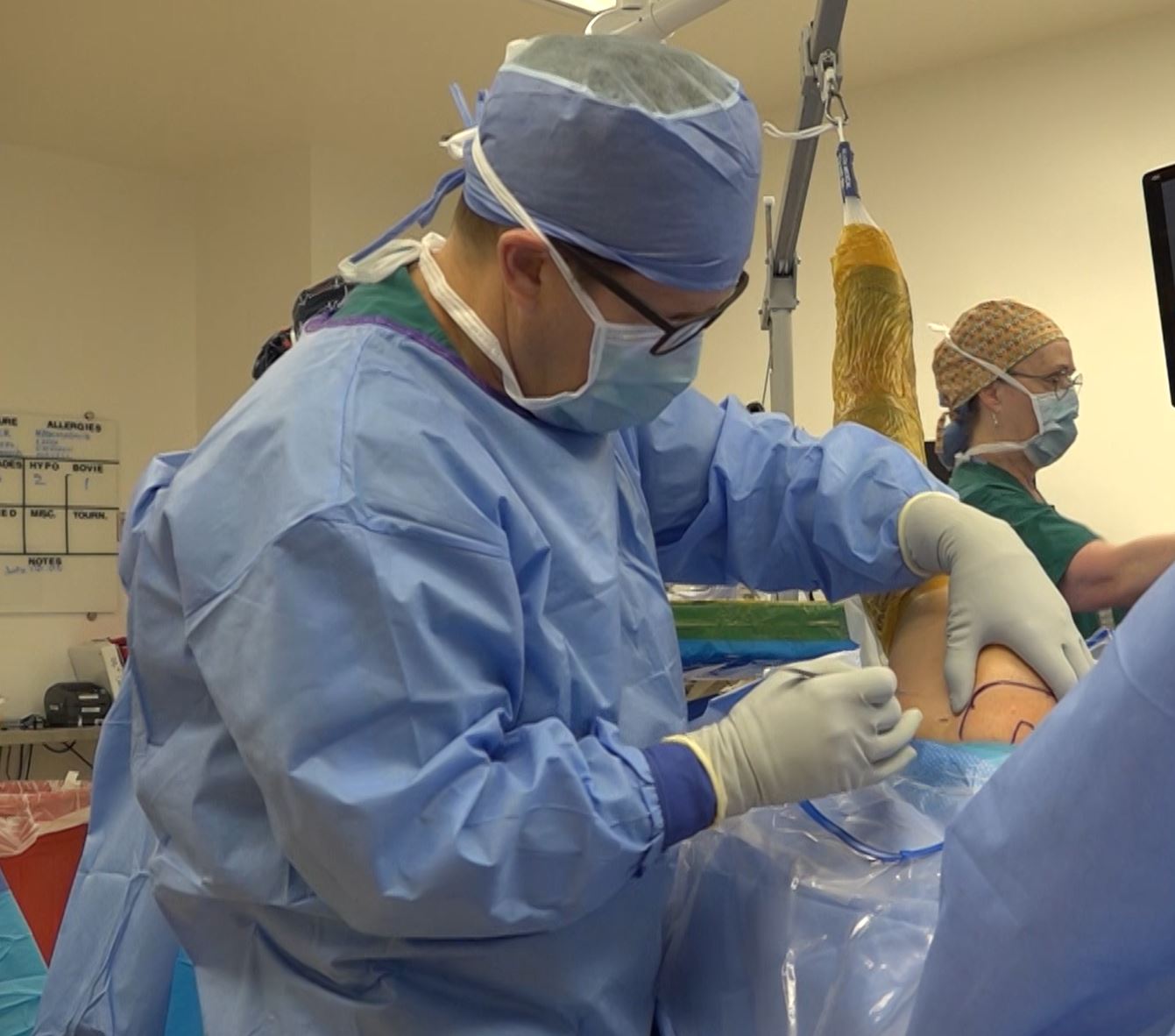VIDEO — Shouldering the pain: EPH surgeon repairs torn rotator cuffs

Chuck Varilek is a retired teacher who continues to pursue his love of music by conducting the Estes Park Village Band the Estes Park Jazz Big Band. A recent slip on a patch of ice during a routine morning walk left him with a painful shoulder injury.
“I took a fall and messed up my shoulder and it ended up being I destroyed my rotator cuff amongst other things, so I’m getting those repaired,” Varilek explained. “As soon as I hit the ground, I knew I had messed myself up.”

In the pre-op area, Varilek was given a regional anesthetic block in his shoulder. The Certified Registered Nurse Anesthetist used ultrasound guidance to place the medicine in the right area. (Photo by Wendy Rigby/Estes Park Health)
Varilek went to Urgent Care for an x-ray. No bones were broken. He was referred to orthopedic surgeon Dr. Gavin Bishop at Estes Park Health.
“The next imaging was an MRI,” Dr. Bishop said. “And the MRI confirmed our suspicion that he had a full thickness tear of his supraspinatus which is one of his rotator cuff muscles and tendons. And it was retracted.”
The rotator cuff is a group of muscles and tendons that act to stabilize the shoulder and allow for range of motion. Varilek could barely lift his left arm.
“The pain was reasonable for him, but really it was more the lack of function that was his bigger concern,” Dr. Bishop noted.
Varilek opted for surgery.
“I want my arm back and I’d like to be able to move it without having a lot of pain,” he stressed.
In the pre-op area, Varilek was given a regional anesthetic block in his shoulder. The Certified Registered Nurse Anesthetist used ultrasound guidance to place the medicine in the right area.
Then it was off to the operating room where he was placed under general anesthesia. When dealing with a tight space like the shoulder, Dr. Bishop uses an arm holding device to open up the area for his tools.
“We can really see everything we need to arthroscopically,” Dr. Bishop stated. “What that means is that we use small incisions throughout the shoulder.”
Working through five tiny incisions about a quarter of an inch in size, Dr. Bishop uses a lighted camera to navigate through the injured shoulder and see what he needs to at multiple angles.
The first small device he inserts into the body is an ultrasonic ablator to clean up the tissue.
“It doesn’t affect the tissue around it,” Dr. Bishop emphasized. “That’s what we use a lot to help visualize and manipulate tissue and clean up tissue.”
The surgeon also uses a small tool called a grasper which allows him to work with a tendon that was inflamed, irritated, and flipping in and out of its normal groove.
“We need to manipulate that tissue to make it move over to its original location,” he said.
Two of the incisions were for suture anchors.
All in all, the procedure took a large team and about two-and-a-half hours. Varilek is expected to make a full recovery.
“The smaller holes can heal faster and hopefully have less impact on the soft tissue that isn’t being worked on,” Dr. Bishop explained. “There are different reasons why someone can tear their rotator cuff. Some of it could be slipping and falling. Some of it could be overuse. Some of it could be another type of injury. Patients tend to do well if we have the right diagnosis and do the right procedure. They tend to recover well and have a good outcome.”
Varilek went home the same day as his surgery. It will still take weeks of recovery and rehab, but he should be back on the bandstand soon. He’s grateful to get the help he needs close to home.
“I’d much prefer this to driving down to the valley and the drive back up and all that,” he added.
For convenient, expert orthopedic care close to home, think Estes Park Health.


